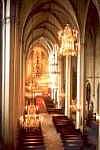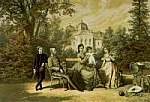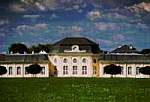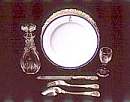
In 1998 the world will remember one of history's most fascinating women. One hundred years ago, on September 10, 1898, Austria's Empress Elisabeth died from wounds inflicted during an assassination attempt. Exhibitions throughout Austria will commemorate the country's beloved Empress. They will document the intriguing life story of a woman who was an "empress against her will", who was at once fairy-tale princess and liberated woman, a dieting fanatic and expert equestrian, a poet and inveterate traveler. The empress, affectionately known to millions as "Sisi", was as intelligent as she was extravagant, and was decades ahead of her time. Although the imperial surroundings of Schönbrunn Palace and the glittering Vienna Hofburg were her home, the consort of the Austrian emperor established a special relationship with all classes of her subjects. Little wonder then that following her tragic death Princess Diana was often likened in obituaries to Sisi: Both were women of extraordinary beauty and represented their countries with dignity and elegance. Both succeeded in winning a special place in people's hearts even amidst the ceremony and protocol of ancient dynasties. Both were dedicated to social causes. And both died tragically before their time.
With her charm and natural grace Elisabeth soon became a fairy-tale princess in the eyes
of the public. In her private life, however, insoluble problems began to make their
appearance. From the first day she arrived in Vienna the young empress felt constrained
and unhappy by the strict life at court, personified by her mother-in-law, Sophie. During
the early years of her marriage, Elisabeth took refuge in isolation and illness. Sisi could not adapt to the strict court etiquette, and soon immersed herself in rigourous exercise and horse riding. Later she spent a lot of time in Madeira and Corfu trying to escape.
After the birth of the crown prince, however, with whose education she was not entrusted, she broke into open rebellion. In 1859, Elisabeth left her husband and small children to live in seclusion on Madeira, Corfu, and in Venice.
Francis Joseph loved his wife dearly, but he ruled over an empire of 50 million people and had little time to be with "Sisi" who felt lonely.
"I wish he were no emperor", she confided her former governess. Although Sisi usually stayed out of politics, she made a great exception as far as Hungary was concerned. Elisabeth's interest in politics developed as she grew matured. She was liberal and forward-minded. The empress placed herself decisively on the Hungarian side in the nationality conflict thereby making an important contribution to the historic compromise of 1867. Hungary's gaining an equal footing with Austria also strengthened the liberal element in the monarchy as a whole. Elisabeth attained an unparalleled position of respect and affection in Hungary, one which has lasted until the present day. It was due to her influnce that the reconciliation with the rebellious peoples of Hungary was established. Elisabeth learned to speak Hungarian fluently and spent more time in Budapest then in Vienna, much to the anger and displeasure of her mother in law and her cohorts in the Viennese Court.
All of these efforts were meant to prove herself as an individual and not as an empress. They were at the same time an expression of Elisabeth's contempt for the monarchy, which she considered a "ruin". Sisi remained consciously individualistic and dedicated herself exclusively to her self-expression and physical beauty. Elisabeth was also a highly educated woman, who not only learned Hungarian and modern Greek perfectly, but who even in later years immersed herself in the world of the ancient Greeks.
Personal blows left heavy marks on the life of Austria's empress. She lost her daughter,
Sophie, in 1857, and her favorite cousin, King Ludwig II of Bavaria, in a tragic fashion.
Her brother-in-law, Emperor Maximilian of Mexico was shot by revolutionaries. She never
was able to get over her most terrible tragedy, the suicide of her son, Rudolph, in 1889.
Her son dead, her favorite daughter happily married, her husband the Emperor was in a mutually satisfying relationship with a lady named
Katharina Schratt, the Empress found herself alone and set out travelling in Italy and Greece.
|

back to Culture & History


Created 1994 by © LabelArt WebDesign - Austria


 Elisabeth was born on Christmas 1837 in Munich, Bavaria, as the daughter of Duke Maximilian
and Maria Ludowika, daughter of the Bavarian king. She grew up in Possenhofen castle
(foto right) far
from the ceremony of court, and developed like her brothers and sisters into an
unconventional, freedom loving, and extremely sensitive person.
Elisabeth was born on Christmas 1837 in Munich, Bavaria, as the daughter of Duke Maximilian
and Maria Ludowika, daughter of the Bavarian king. She grew up in Possenhofen castle
(foto right) far
from the ceremony of court, and developed like her brothers and sisters into an
unconventional, freedom loving, and extremely sensitive person.



 In 1855, Sisi gave birth to a daughter, Sophie, and in the following year to another girl, Gisela. Finally, in 1858 the long-awaited crown prince, Rudolph, arrived.
In 1855, Sisi gave birth to a daughter, Sophie, and in the following year to another girl, Gisela. Finally, in 1858 the long-awaited crown prince, Rudolph, arrived. The official public explanation was "severe illness". Her children were forced from her and had to remain in the hands of her mother-in-law and the court. (right: Postcard "Departure of the Empress")
The official public explanation was "severe illness". Her children were forced from her and had to remain in the hands of her mother-in-law and the court. (right: Postcard "Departure of the Empress")

 In the 1860's Elisabeth was considered the world's most beautiful monarch. In the 1870's she became the most famous, and probably also the world's best, female equestrian. She
trained as hard as a professional sportswoman for years to achieve this goal. After the
Hungarian compromise had been reached, Elisabeth had little choice but to withdraw from politics. Later when gout made riding impossible she tried to make a name for herself as a
poet in the mold of Heinrich Heine, who she revered.
In the 1860's Elisabeth was considered the world's most beautiful monarch. In the 1870's she became the most famous, and probably also the world's best, female equestrian. She
trained as hard as a professional sportswoman for years to achieve this goal. After the
Hungarian compromise had been reached, Elisabeth had little choice but to withdraw from politics. Later when gout made riding impossible she tried to make a name for herself as a
poet in the mold of Heinrich Heine, who she revered.

